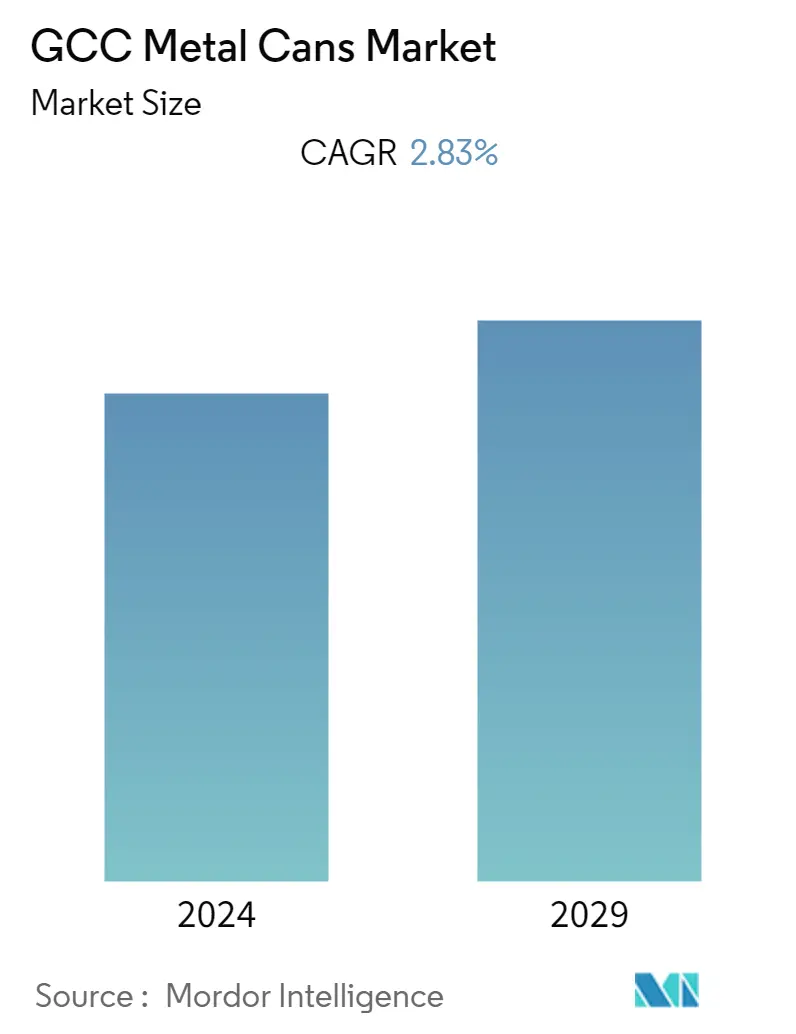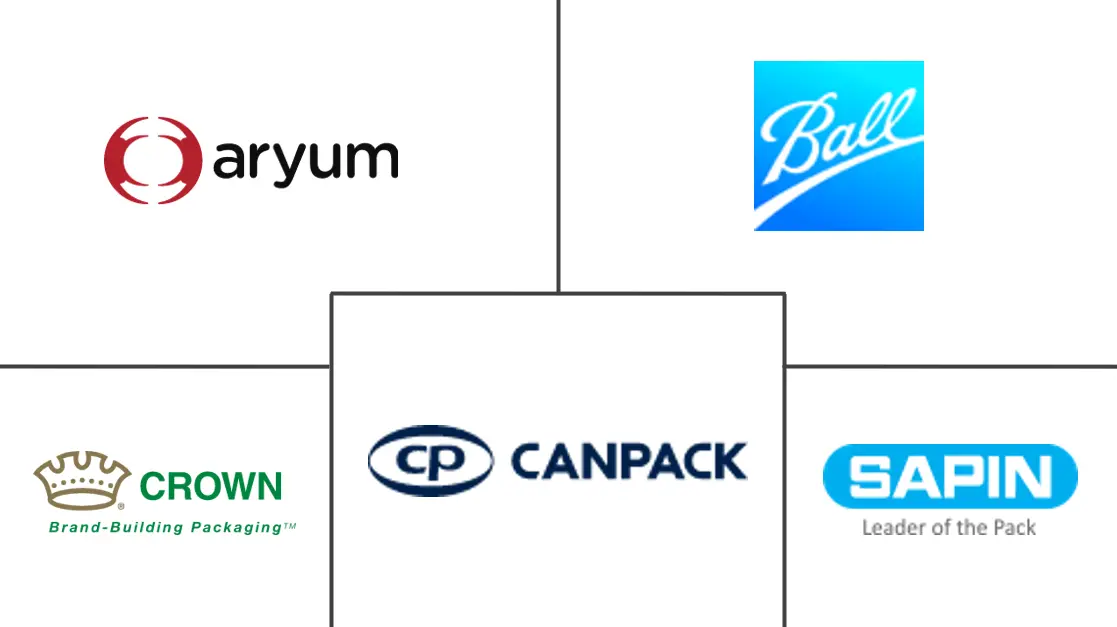Market Size of GCC Metal Cans Industry

| Study Period | 2019 - 2029 |
| Base Year For Estimation | 2023 |
| Forecast Data Period | 2024 - 2029 |
| Historical Data Period | 2019 - 2022 |
| CAGR | 2.83 % |
| Market Concentration | Medium |
Major Players
*Disclaimer: Major Players sorted in no particular order |
GCC Metal Cans Market Analysis
The GCC metal cans market is expected to register a CAGR of 2.83% over the forecast period (2022 - 2027). The product is gaining prominence due to its distinct features, such as resistance to transportation, hermetically sealed cover, irregular handling, and easy recyclability.
- The high recyclability of metal cans is one of the significant drivers of the market. Making products from recycled metals uses less energy, reduces carbon emissions, and uses less water compared with using raw materials.
- Owing to the increasing consumption of both alcoholic and non-alcoholic beverages, such as beer and carbonated drinks, in GCC, there is significant demand for metal cans in the region. According to a new report from the Dubai Chamber of Commerce, the UAE's food and beverage trade grew steadily to more than USD 20 billion in the first nine months of 2021.
- Moreover, consumer trends, such as a preference for small-size and multi-pack packaging formats, are also supporting the volume growth of the metal cans market in the region. For instance, in March 2022, Rexam's chief executive said that growth prospects for the beverage can in the Middle-East were attractive, and they look forward to working together with their partners in UAC to lead further expansion in the region.
- The rise in consumer awareness concerning the application of non-carcinogenic materials in packaging and increased demand for lightweight packing is generating high growth prospects for the metal cans market. However, due to the replacement possibility of polymer-based packaging materials, including polyethylene and polyethylene terephthalate (PET), metal cans are witnessing a challenge in their usage.
- In response to the COVID-19 pandemic's impact on demand, GCC aluminum production has swiftly increased by 179 thousand metric ton in 2020, while producing only 5654 thousand metric tonnes of aluminum in 2019, as per International Aluminum Institute. Also, the non-ferrous metals industry is a key supplier of essential value chains, including food packaging. COVID-19 is causing significant and growing economic impacts on the GCC non-ferrous metals sector, caused by major demand reduction in key-value chains, supply disruptions, and transport difficulties.
GCC Metal Cans Industry Segmentation
The metal can is a container for the distribution or storage of goods. It is composed of thin metal, which is prominently propelled by its growing use in food and beverage packaging. Due to changing lifestyles, growing alcoholic and non-alcoholic beverages requirement, rising disposable income, and rising need for processed foods are marking the growth of this market. The GCC metal cans market is segmented by material (Aluminum Cans, Steel/Tin Cans), by application (Beverage Cans, Food Cans, and Aerosol Cans), and by country.
| By Material | |
| Aluminum Cans | |
| Steel/Tin Cans |
| By Application | |||||
| |||||
| |||||
| Aerosol Cans (Cosmetic, Household, and Pharmaceutical) | |||||
| Other Consumer cans |
| By Country | |
| United Arab Emirates (UAE) | |
| Saudi Arabia | |
| Rest of GCC |
GCC Metal Cans Market Size Summary
The GCC metal cans market is experiencing steady growth, driven by the increasing demand for packaging solutions that offer durability, recyclability, and environmental benefits. Metal cans are gaining traction due to their resistance to transportation challenges, hermetic sealing, and ease of recycling, which aligns with the region's growing focus on sustainability. The rising consumption of beverages, both alcoholic and non-alcoholic, is a significant factor propelling the demand for metal cans in the GCC. Consumer preferences for smaller and multi-pack packaging formats further support market expansion. However, the market faces challenges from the potential replacement by polymer-based packaging materials, which could impact the adoption of metal cans.
The United Arab Emirates is poised to dominate the GCC metal cans market, driven by its burgeoning demand for organic foods and beverages. The country's strategic initiatives, such as the 'Made in UAE' program, are enhancing local manufacturing capabilities and reducing reliance on imports, thereby boosting the packaging industry. The growing expatriate population and the increasing demand for packaging solutions in the personal care and cosmetics sectors are also contributing to market growth. The competitive landscape is moderately fragmented, with key players like Ball Corporation and Rexam actively innovating and expanding their operations in the region. Despite challenges posed by the COVID-19 pandemic, the market outlook remains positive, supported by ongoing investments and strategic partnerships aimed at enhancing production capabilities and sustainability.
GCC Metal Cans Market Size - Table of Contents
-
1. MARKET DYNAMICS
-
1.1 Market Drivers
-
1.1.1 Improving Income Level and Development of Retail Systems is increasing the Consumption of Packaged Food & Beverages
-
-
1.2 Market Challenges
-
1.2.1 Growing Demand for alternatives such as flexible plastics in the Food Industry
-
-
1.3 Market Opportunities
-
-
2. MARKET SEGMENTATION
-
2.1 By Material
-
2.1.1 Aluminum Cans
-
2.1.2 Steel/Tin Cans
-
-
2.2 By Application
-
2.2.1 Beverage Cans
-
2.2.1.1 Alcoholic
-
2.2.1.2 Non-Alcoholic
-
-
2.2.2 Food Cans
-
2.2.2.1 Vegetables and Fruits
-
2.2.2.2 Pet Food
-
2.2.2.3 Soups and Other Food
-
-
2.2.3 Aerosol Cans (Cosmetic, Household, and Pharmaceutical)
-
2.2.4 Other Consumer cans
-
-
2.3 By Country
-
2.3.1 United Arab Emirates (UAE)
-
2.3.2 Saudi Arabia
-
2.3.3 Rest of GCC
-
-
GCC Metal Cans Market Size FAQs
What is the current GCC Metal Cans Market size?
The GCC Metal Cans Market is projected to register a CAGR of 2.83% during the forecast period (2024-2029)
Who are the key players in GCC Metal Cans Market?
ARYUM Metal Alüminyum Tüp, Ball Corporation, Crown Holdings, SAPIN SA and CAN-PACK MIDDLE EAST LLC are the major companies operating in the GCC Metal Cans Market.

